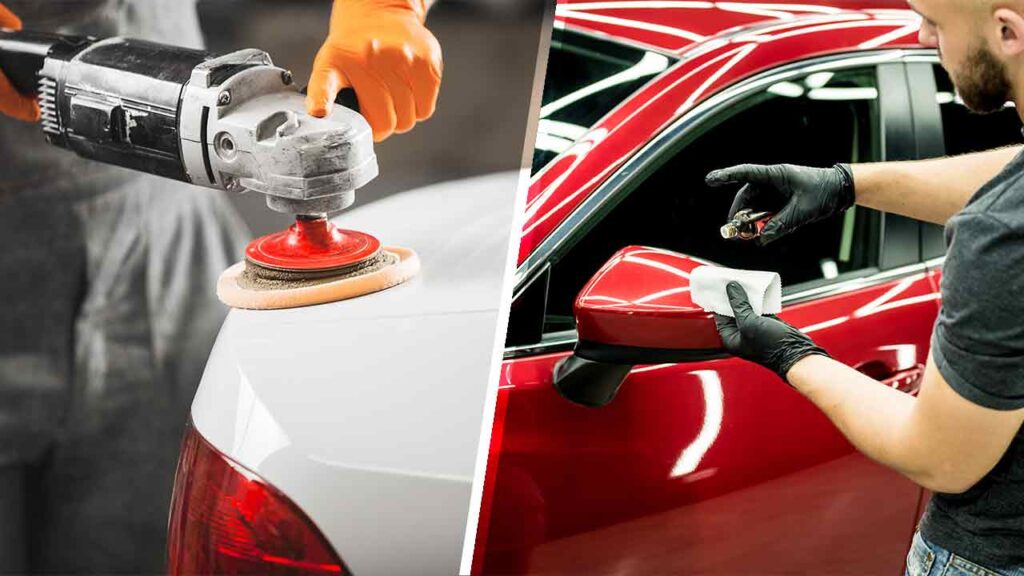Paint protection has evolved dramatically since the days of elbow grease and carnauba wax. Modern ceramic coatings promise unprecedented protection and durability, yet traditional waxing maintains a devoted following among car enthusiasts. Understanding the science, benefits, and limitations of each approach helps car owners make informed decisions about protecting their vehicle’s finish. Let’s explore these two popular protection methods through the lens of both science and practical application.
Understanding the Fundamental Differences
Traditional car wax typically consists of natural carnauba wax blended with synthetic polymers and solvents. This mixture creates a sacrificial layer that sits on top of your paint, similar to how floor wax protects wooden surfaces. Ceramic coatings, by contrast, utilize silicon dioxide (SiO2) or similar compounds that chemically bond with your vehicle’s paint surface, creating a semi-permanent protective layer that becomes part of the paint’s structure.
The Science of Protection
Ceramic coatings work through a process called covalent bonding, where the coating’s molecules actually link with the molecules in your car’s clear coat. Imagine building a microscopic shield that’s chemically fused to your paint. This creates an extremely durable layer that resists environmental contaminants, UV rays, and chemical exposure. The resulting surface exhibits hydrophobic properties, causing water and other liquids to bead up and roll off rather than sitting on the paint.
Traditional wax provides protection through a different mechanism. The wax molecules fill microscopic imperfections in the paint surface while creating a hydrophobic barrier through their natural water-repelling properties. However, this barrier remains separate from the paint itself, making it more susceptible to environmental degradation and requiring regular reapplication to maintain protection.
Durability and Longevity Considerations
Ceramic coatings typically last between two to five years, with some premium options claiming even longer durability. This longevity stems from their chemical bonding with the paint surface, making them highly resistant to normal washing, environmental exposure, and even mild chemical contact. Once properly cured, a ceramic coating maintains its protective properties until physically abraded away through mechanical means.
Traditional wax, while effective, typically lasts between one to three months depending on environmental conditions and exposure. This shorter lifespan results from the wax layer gradually breaking down through normal washing, environmental exposure, and oxidation. Regular reapplication becomes necessary to maintain protection, though this process also provides an opportunity to inspect and maintain the paint surface regularly.
Application Process and Requirements
Ceramic coating application demands meticulous preparation and precise conditions. The paint surface must be thoroughly cleaned, clay barred, and often paint corrected before application. The coating itself requires careful application in controlled environments, with specific temperature and humidity requirements. Professional application often takes multiple days and requires significant expertise to ensure proper bonding and durability.
Traditional waxing proves more forgiving in terms of application requirements. While proper paint preparation still improves results, wax can be applied in various environmental conditions and typically requires minimal specialized knowledge or equipment. The process usually takes a few hours at most, making it more accessible for DIY enthusiasts. However, achieving optimal results still requires attention to detail and proper technique.
Cost Analysis and Value Proposition
Ceramic coatings represent a significant upfront investment, often ranging from several hundred to a few thousand dollars for professional application. This cost includes proper paint preparation, the coating itself, and professional labor. However, when considering the multi-year protection provided, the annual cost often proves competitive with regular professional waxing services.
Traditional waxing costs less initially but requires more frequent reapplication. Quality waxes might cost between $20-100 per container, with each application using a portion of the product. Professional waxing services typically range from $50-200 per application, needed every few months for optimal protection. Over several years, these recurring costs can exceed the one-time investment in ceramic coating.
Performance in Different Environments
Environmental conditions significantly impact protection needs. Ceramic coatings excel in harsh environments, providing superior protection against acid rain, bird droppings, tree sap, and UV radiation. Their chemical resistance and durability make them particularly valuable in urban areas or regions with extreme weather conditions.
Traditional wax performs admirably in moderate conditions but may require more frequent reapplication in challenging environments. However, wax often proves more effective at filling minor swirl marks and surface imperfections, temporarily improving paint appearance. This characteristic makes wax particularly appealing for older vehicles or those with less-than-perfect paint.
Maintenance Requirements
Ceramic-coated vehicles require specific maintenance practices to maximize coating longevity and performance. While general washing becomes easier due to the coating’s hydrophobic properties, certain chemicals and washing techniques should be avoided to prevent coating degradation. Regular maintenance typically involves specialized ceramic coating maintenance sprays that help maintain hydrophobic properties and protection levels.
Waxed vehicles demand more frequent attention but allow more flexibility in maintenance approaches. Regular washing and periodic reapplication of wax help maintain protection, though the process proves more time-consuming over the long term. The forgiving nature of wax allows for easier correction of any application mistakes or uneven wear patterns.
Making the Right Choice
The decision between ceramic coating and traditional wax depends heavily on individual circumstances, including vehicle value, environmental conditions, desired maintenance level, and budget considerations. Ceramic coatings often prove most valuable for new vehicles or those with excellent paint condition, where long-term protection justifies the initial investment. Traditional waxing remains an excellent choice for older vehicles, those with imperfect paint, or situations where regular maintenance aligns with owner preferences and habits.
Consider your personal goals and circumstances when choosing between these options. Sometimes, a hybrid approach proves most effective, using ceramic coating for long-term protection while occasionally applying wax for enhanced gloss or temporary correction of minor imperfections. Understanding the strengths and limitations of each option helps ensure satisfaction with your paint protection choice.
















Add Comment